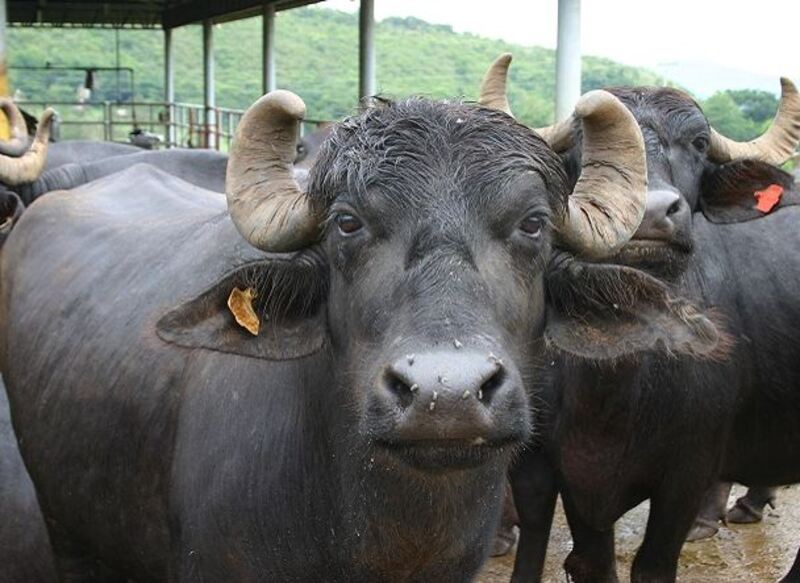Pneumonia in Buffalo can stem from many different causes. To learn more about this, please read the article below. Through which you also know the effective medicine, don't miss it!
Learn about pneumonia in Buffalo
In the process of raising cattle, it is difficult to avoid animals getting sick. One of them is pneumonia in Buffalo Bo. To learn more about this issue, please take the time to read the following content:
Causes of pneumonia in buffaloes and cows
Pneumonia in cattle can appear at any time of the year. Above all, the cause of this condition must include factors such as:
Bacterial infection
In fact, pneumonia often occurs in dairy cows, especially calves under 1 year old. On top of that, the disease is even more advanced when the animal is in adulthood. One of the typical causes of this condition is that cattle are infected with bacteria, viruses:
Transfer season
Moreover, pneumonia in Buffaloes can be caused by weather changes. Accordingly, the North often changes the season from Autumn to Winter, the South changes from the dry season to the rainy season. Due to sudden changes in temperature, cattle are susceptible to respiratory diseases.

Symptom
Pneumonia in Buffalo has an incubation period of 3 to 7 days. Thereafter, cattle present with clinical symptoms characteristic of pneumonia such as:
How to prevent illness
It is easy to see that pneumonia in Buffalo is quite dangerous, develops quickly, and has a high mortality rate. Therefore, you need to have a specific prevention plan to minimize the damage in livestock. These are typical things:

Using Beta Cef 25 specifically to treat pneumonia in buffaloes and cows
When buffaloes and cows have pneumonia, preventive measures are not appreciated. Instead, you need to use Beta Cef 25 to stop unpleasant symptoms for livestock. At the same time, you also minimize the possibility of death due to not being treated in time.
Cefquinome Sulfate antibiotic effectively treats pneumonia
Beta Cef 25 drug with the main ingredient is Cefquinome Sulfate to treat pneumonia in cattle. This is a 4th generation cefalosporinem antibiotic with a broad spectrum of antibacterial activity. From there, Gram-negative and Gram-positive bacteria are quickly destroyed.
Therefore, the drug Beta Cef 25 has a fast acting, long lasting effect. In addition, studies have shown that cefquinome does not cause any harm to the fetus. Therefore, you can use it for pregnant animals and rest assured with the reproductive system of livestock.
Injected deep under the muscle or under the skin
When using Cefquinome to treat pneumonia in cattle, you can inject it under the muscle. Besides, livestock households also easily apply the method of subcutaneous injection. However, you need precise positioning for the best effect in the healing process.
Dosage and uses of Beta Cef 25
Moreover, you need to grasp the exact dose and use of Beta Cef 25. Detailed information is in the following table:
| Ingredient | - Cefquinome Sulfate: 2,500 mg. – Special excipients just enough: 100 ml. |
| Uses | This drug is capable of treating the following diseases: – Special treatment for respiratory infections, asthma, pneumonia, pleurisy, diarrhea, E.coli. – Treatment of mastitis, latent mastitis, metritis, dry milk, dermatitis, nail interstitial inflammation, urinary tract inflammation. – Treatment of hematoma, paratyphoid, Lepto, swollen head, sepsis. |
| Usage – dosage | - Inject deep intramuscular or subcutaneous. - Dosage 1 ml/25 to 30 kg B.W. |
| Specifications | – 20 ml. – 100 ml. |
| Preserve | Store the medicine in a cool dry place but avoid direct sunlight. Should be stored in a place where the temperature does not exceed 300C. Keep out of reach of children |
 Van Phuc, Ho Chi Minh, Viet Nam
Van Phuc, Ho Chi Minh, Viet Nam
 (0274) 377 66 11
(0274) 377 66 11
 ada@adabiotechvn.com
ada@adabiotechvn.com
 adabiotechvn.com
adabiotechvn.com